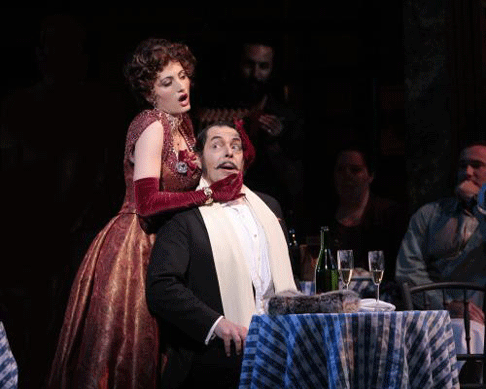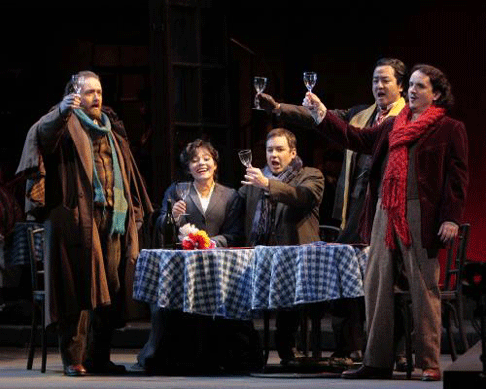The Los Angeles production was
created by the late movie director Herbert Ross in 1993. But Los Angeles is not
alone in succumbing to old love. The Metropolitan Opera’s 2011-12 season
included Franco Zeffirelli’s La BohËme, created in 1981, famous for
its heavily populated (think about 240 bodies) CafÈ Momus scene,which
catapulted the opera into the most produced at the Met. And just last month, in
May 2012 , Britain’s Royal Opera Company staged an even more ancient La
BohËme created by John Copley in 1974.
Copley, the only one of the above producers still alive, was recently
interviewed on the subject, and suggested that the basic reason for his
production’s survival was that “It’s traditional, and people like it.”
Perhaps it’s as simple as all that. All three of these long running productions
are essentially technologically free, closely modeled on the clothes,
furnishings and cultural aspects of an era that remains highly romanticized
after almost two centuries. (The Los Angeles production features views of the
unfinished Eiffel Tower.) Likely these romantic visions of Paris are easy to
take and easy to understand, in that they present no challenge to new opera
goers, and feel as comfortable as old slippers to many who have experienced
them before.
Puccini’s libretto was created by Luigi Illica and Giuseppe Giacosa. It is
derived from ScËnes de la vie de bohËme by Henri Murger. Murger
began publishing a series of loosely knit scenes of Bohemian life by that title
in 1845. They were not particularly successful until he combined some of them
into a play in 1849. Subsequently they were revised and turned into a novel
called La vie bohËme. A Parisian “Bohemian”, himself, Murger
seems not to have been a very organized fellow. In his novel MimÏ dies alone
at a hospital. In his play she dies on stage. Puccini’s La BohËme
followed the stage play, while at the same time, he and his librettists denied
it because the play was copyrighted. Puccini’s opera premiered in 1896. The
following year another La BohËme premiered – this by Ruggero
Leoncavallo, composer of Pagliacci. The latter work, which first gave Puccini’s
opera some competition, is (although Leoncavallo’s MimÏ also dies in Rodolfo’s
attic) a far less romantic tale, and soon after fell from grace.
The Los Angeles opera assembled a young and handsome cast featuring married
couple Ailyn PÈrez and Stephen Costello as MimÏ and the poet Rodolfo. This
was Costello’s Los Angeles debut, though both are well known to San Diego opera
lovers. Both too, are Richard Tucker award winners, and both now have
burgeoning European careers. Costello has appeared at the Met and at
Glyndebourne.
 Valentina Fleer as Musetta and Philip Cokorinos as Alcindoro
Valentina Fleer as Musetta and Philip Cokorinos as Alcindoro
PÈrez recently debuted at Convent Garden and at La Scala. PÈrez
is a particularly engaging and intelligent soprano, who is able to reflect
emotions in her voice. Her sweet, coy MimÏ suited the romantic setting. I’ve
seen and heard Costello clear tenor many times, but at the May 26th performance
I attended, his voice seemed somewhat strained and his Rodolfo did not catch
fire. There was fire enough to go around, however, in baritone Artur
Ruci?ski’s well sung Marcello, and in Valentina Fleer’s high strung and
amusing Musetta. Both artists were debuting with the company. Museop Kim’s
bright baritone made for an entertaining Schaunard. But a major flaw in
direction had bass Robert Pomakov, the philosopher, Colline, pick up his
overcoat, leave the attic in which MimÏ was dying and stand on a street corner
to sing “addio vecchio zimarra” his touching farewell to the garment he is
sacrificing to buy medicine for Mimi. The meaning was totally lost. Though
conductor Patrick Summers, also debuting with the company, set some tempos a
bit slowly, Musetta’s waltz, for example, he allowed the orchestra to sing
Puccini’s score as romantically as did his vocal artists. And that’s good. It’s
what makes Puccini’s operas so emotionally involving and intense.
 Left to right: Robert Pomakov as Colline, Ailyn Perez as Mimi, Stephen Costello as Rodolfo, Museop Kim as Schaunard and Artur Rucinski as Marcello
Left to right: Robert Pomakov as Colline, Ailyn Perez as Mimi, Stephen Costello as Rodolfo, Museop Kim as Schaunard and Artur Rucinski as Marcello
For all the romanticism and verisimilitude of the costumes and set, the
bohemian’s attic, though elevated, was small and upstage. It diminished the
size of the singers and of their voices. Ross was a movie director. Perhaps
filming into the attic would have created a more striking effect.
Nevertheless, at its conclusion, this La BohËme like thousands
before it, had the gala sold out audience, standing and cheering.
And as usual, I had cried.
Estelle Gilson
Click
here for a media slideshow.
image=http://www.operatoday.com/3602-lbhm5069.gif
image_description=Stephen Costello as Rodolfo and Ailyn Perez as Mimi [Photo by Robert Millard for LA Opera]
product=yes
product_title=Giacomo Puccini: La BohËme
product_by=Marcello:Artur Ruci?ski; Rodolfo:Stephen Costello; Colline:Robert Pomakov; Schaunard:Museop Kim; Benoit:Philip Cokorinos; MimÏ:Ailyn PÈrez; Musetta: Valentina Fleer; Alcindoro:Philip Cokorinos. Conductor: Patrick Summers. Production: Herbert Ross. Dierector: Gregory A.Fortner. Set Designer: Gerard Howland. Costume designer: Peter J. Hall. Lighting Designer: Daniel Ordower. Choreographer: Peggy Hickey . Associate Conductor/Chorus Master: Grant Gershon.
product_id=Above: Stephen Costello as Rodolfo and Ailyn Perez as Mimi
Photos by Robert Millard for LA Opera